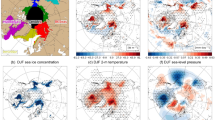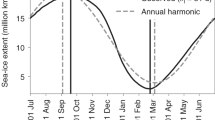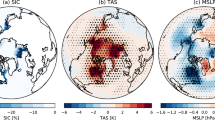Abstract
Arctic sea ice has decreased substantially over recent decades, a trend projected to continue. Shrinking ice reduces surface albedo, leading to greater surface solar absorption, thus amplifying warming and driving further melt. This sea-ice albedo feedback (SIAF) is a key driver of Arctic climate change and an important uncertainty source in climate model projections. Using an ensemble of models, we demonstrate an emergent relationship between future SIAF and an observable version of SIAF in the current climate’s seasonal cycle. This relationship is robust in constraining SIAF over the coming decades (Pearson’s r = 0.76), and then it degrades. The degradation occurs because some models begin producing ice-free conditions, signalling a transition to a new ice regime. The relationship is strengthened when models with unrealistically thin historical ice are excluded. Because of this tight relationship, reducing model errors in the current climate’s seasonal SIAF and ice thickness can narrow SIAF spread under climate change.
This is a preview of subscription content, access via your institution
Access options
Access Nature and 54 other Nature Portfolio journals
Get Nature+, our best-value online-access subscription
$29.99 / 30 days
cancel any time
Subscribe to this journal
Receive 12 print issues and online access
$209.00 per year
only $17.42 per issue
Buy this article
- Purchase on Springer Link
- Instant access to full article PDF
Prices may be subject to local taxes which are calculated during checkout





Similar content being viewed by others
Data availability
The data that support the findings of this study are publicly available. The CMIP5 output is available from the Earth System Grid Federation (https://esgf-node.llnl.gov/projects/cmip5/). Satellite albedo data are available from https://www.ncei.noaa.gov/data/avhrr-polar-pathfinder-extended/access/ and https://wui.cmsaf.eu/safira/action/viewDoiDetails?acronym=CLARA_AVHRR_V002. The temperature reanalyses datasets are available from https://www.esrl.noaa.gov/psd/data/gridded/data.ncep.reanalysis2.html and https://gmao.gsfc.nasa.gov/reanalysis/MERRA-2/data_access/. The ice thickness data can be downloaded from http://psc.apl.uw.edu/research/projects/arctic-sea-ice-volume-anomaly/data/. Source data for Figs. 2, 4 and 5 is available online.
Code availability
The code relating to this study is available from the corresponding author on request.
References
Flanner, M. G., Shell, K. M., Barlage, M., Perovich, D. K. & Tschudi, M. A. Radiative forcing and albedo feedback from the Northern Hemisphere cryosphere between 1979 and 2008. Nat. Geosci. 4, 151–155 (2011).
Cavalieri, D. J. & Parkinson, C. L. Arctic sea ice variability and trends, 1979–2010. Cryosphere 6, 881–889 (2012).
Notz, D. & Stroeve, J. C. Observed Arctic sea-ice loss directly follows anthropogenic CO2 emission. Science 354, 747–750 (2016).
Comiso, J. C., Meier, W. N. & Gersten, R. A. Variability and trends in the Arctic Sea ice cover: results from different techniques. J. Geophys. Res. Oceans 122, 6883–6900 (2017).
Stroeve, J. & Notz, D. Changing state of Arctic sea ice across all seasons. Environ. Res. Lett. 13, 103001 (2018).
Kwok, R. & Rothrock, D. A. Decline in Arctic sea ice thickness from submarine and ICESat records: 1958–2008. Geophys. Res. Lett. 36, L15501 (2009).
Lang, A., Yang, S. & Kaas, E. Sea ice thickness and recent Arctic warming. Geophys. Res. Lett. 44, 409–418 (2017).
Kwok, R. Arctic sea ice thickness, volume, and multiyear ice coverage: losses and coupled variability (1958–2018). Environ. Res. Lett. 13, 105005 (2018).
Stroeve, J. C. et al. Trends in Arctic sea ice extent from CMIP5, CMIP3 and observations. Geophys. Res. Lett. 39, L16502 (2012).
Hall, A. The role of surface albedo feedback in climate. J. Clim. 17, 1550–1568 (2004).
Bony, S. et al. How well do we understand and evaluate climate change feedback processes? J. Clim. 19, 3445–3482 (2006).
Goosse, H. et al. Quantifying climate feedbacks in polar regions. Nat. Commun. 9, 1919 (2018).
Holland, M. M. & Bitz, C. M. Polar amplification of climate change in coupled models. Clim. Dynam. 21, 221–232 (2003).
Soden, B. & Held, I. An assessment of climate feedbacks in coupled ocean–atmosphere models. J. Clim. 19, 3354–3360 (2006).
Screen, J. A. & Simmonds, I. The central role of diminishing sea ice in recent Arctic temperature amplification. Nature 464, 1334–1337 (2010).
Screen, J. A., Deser, C. & Simmonds, I. Local and remote controls on observed Arctic warming. Geophys. Res. Lett. 39, L10709 (2012).
Comiso, J. C. & Hall, D. K. Climate trends in the Arctic as observed from space. WIREs. Clim. Change 5, 389–409 (2014).
Graversen, R. G., Langen, P. L. & Mauritsen, T. Polar amplification in CCSM4: contributions from the lapse rate and surface albedo feedbacks. J. Clim. 27, 4433–4450 (2014).
Pithan, F. & Mauritsen, T. Arctic amplification dominated by temperature feedbacks in contemporary climate models. Nat. Geosci. 7, 181–184 (2014).
Boé, J., Hall, A. & Qu, X. Current GCMs’ unrealistic negative feedback in the Arctic. J. Clim. 22, 4682–4695 (2009).
Dai, A., Luo, D., Song, M. & Liu, J. Arctic amplification is caused by sea-ice loss under increasing CO2. Nat. Commun. 10, 121 (2019).
Qu, X. & Hall, A. On the persistent spread in snow-albedo feedback. Clim. Dynam. 42, 69–81 (2014).
Thackeray, C. W. & Fletcher, C. G. Snow albedo feedback: current knowledge, importance, outstanding issues and future directions. Prog. Phys. Geogr. 40, 392–408 (2016).
Winton, M. Surface albedo feedback estimates for the AR4 climate models. J. Clim. 19, 359–365 (2006).
Colman, R. A. Surface albedo feedbacks from climate variability and change. J. Geophys. Res. Atmos. 118, 2827–2834 (2013).
Hall, A. & Qu, X. Using the current seasonal cycle to constrain snow albedo feedback in future climate change. Geophys. Res. Lett. 33, L03502 (2006).
Klein, S. A. & Hall, A. Emergent constraints for cloud feedbacks. Curr. Clim. Change Rep. 1, 276–287 (2015).
Eyring, V. et al. Taking climate model evaluation to the next level. Nat. Clim. Change 9, 102–110 (2019).
Hall, A., Cox, P., Huntingford, C. & Klein, S. Progressing emergent constraints on future climate change. Nat. Clim. Change 9, 269–278 (2019).
Crook, J. A. & Forster, P. M. Comparison of surface albedo feedback in climate models and observations. Geophys. Res. Lett. 41, 1717–1723 (2014).
Andry, O., Bintanja, R. & Hazeleger, W. Time-dependent variations in the Arctic’s surface albedo feedback and the link to seasonality in sea ice. J. Clim. 30, 393–410 (2017).
Levis, S., Bonan, G. B. & Lawrence, P. J. Present-day springtime high-latitude surface albedo as a predictor of simulated climate sensitivity. Geophys. Res. Lett. 34, 2–5 (2007).
Holland, M. M., Bitz, C. M., Hunke, E. C., Lipscomb, W. H. & Schramm, J. L. Influence of the sea ice thickness distribution on polar climate in CCSM3. J. Clim. 19, 2398–2414 (2006).
Fletcher, C. G., Thackeray, C. W. & Burgers, T. M. Evaluating biases in simulated snow albedo feedback in two generations of climate models. J. Geophys. Res. 120, 12–26 (2015).
Onarheim, I. H. & Årthun, M. Toward an ice-free Barents Sea. Geophys. Res. Lett. 44, 8387–8395 (2017).
Massonnet, F. et al. Arctic sea-ice change tied to its mean state through thermodynamic processes. Nat. Clim. Change 8, 599–603 (2018).
Schneider, A., Flanner, M. & Perket, J. Multidecadal variability in surface albedo feedback across CMIP5 models. Geophys. Res. Lett. 45, 1972–1980 (2018).
Bowman, K. W., Cressie, N., Qu, X. & Hall, A. A hierarchical statistical framework for emergent constraints: application to snow-albedo feedback. Geophys. Res. Lett. 45, 13050–13059 (2018).
Pistone, K., Eisenman, I. & Ramanathan, V. Observational determination of albedo decrease caused by vanishing Arctic sea ice. Proc. Natl Acad. Sci. USA 111, 3322–3326 (2014).
Cao, Y., Liang, S., Chen, X. & He, T. Assessment of sea ice albedo radiative forcing and feedback over the Northern Hemisphere from 1982 to 2009 using satellite and reanalysis data. J. Clim. 28, 1248–1259 (2015).
Massonnet, F. et al. Constraining projections of summer Arctic sea ice. Cryosphere 6, 1383–1394 (2012).
Rosenblum, E. & Eisenman, I. Sea ice trends in climate models only accurate in runs with biased global warming. J. Clim. 30, 6265–6278 (2017).
Dakos, V. et al. Slowing down as an early warning signal for abrupt climate change. Proc. Natl Acad. Sci. USA 105, 14308–14312 (2008).
Taylor, K. E., Stouffer, R. J. & Meehl, G. A. An overview of CMIP5 and the experiment design. Bull. Am. Meteorol. Soc. 93, 485–498 (2012).
Stroeve, J., Barrett, A., Serreze, M. & Schweiger, A. Using records from submarine, aircraft and satellites to evaluate climate model simulations of Arctic sea ice thickness. Cryosphere 8, 1839–1854 (2014).
Wang, X. & Key, J. R. Arctic surface, cloud, and radiation properties based on the AVHRR polar pathfinder dataset. Part I: spatial and temporal characteristics. J. Clim. 18, 2575–2593 (2005).
Karlsson, K. G. et al. CLARA-A2: the second edition of the CM SAF cloud and radiation data record from 34 years of global AVHRR data. Atmos. Chem. Phys. 17, 5809–5828 (2017).
Kanamitsu, M. et al. NCEP-DOE AMIP-II reanalysis (R-2). Bull. Am. Meteorol. Soc. 83, 1631–1643 (2002).
Gelaro, R. et al. The modern-era retrospective analysis for research and applications, version 2 (MERRA-2). J. Clim. 30, 5419–5454 (2017).
Zhang, J. & Rothrock, D. A. Modeling global sea ice with a thickness and enthalpy distribution model in generalized curvilinear coordinates. Mon. Weather Rev. 131, 845–861 (2003).
Schweiger, A. et al. Uncertainty in modeled Arctic sea ice volume. J. Geophys. Res. 116, C00D06 (2011).
Laxon, S. W. et al. CryoSat-2 estimates of Arctic sea ice thickness and volume. Geophys. Res. Lett. 40, 732–737 (2013).
Saunois, M., Jackson, R. B., Bousquet, P., Poulter, B. & Canadell, J. G. The growing role of methane in anthropogenic climate change. Environ. Res. Lett. 11, 120207 (2016).
Soden, B. J. et al. Quantifying climate feedbacks using radiative kernels. J. Clim. 21, 3504–3520 (2008).
Melia, N., Haines, K. & Hawkins, E. Improved Arctic sea ice thickness projections using bias-corrected CMIP5 simulations. Cryosphere 9, 2237–2251 (2015).
Jahn, A., Kay, J. E., Holland, M. M. & Hall, D. M. How predictable is the timing of a summer ice-free Arctic? Geophys. Res. Lett. 43, 9113–9120 (2016).
Notz, D. & Stroeve, J. The trajectory towards a seasonally ice-free Arctic Ocean. Curr. Clim. Change Rep. 4, 407–416 (2018).
Screen, J. A. & Deser, C. Pacific Ocean variability influences the time of emergence of a seasonally ice-free Arctic Ocean. Geophys. Res. Lett. 46, 2222–2231 (2019).
Acknowledgements
We acknowledge funding from the National Science Foundation grant (no. 1543268) titled ‘Reducing Uncertainty Surrounding Climate Change Using Emergent Constraints’. We also thank the World Climate Research Programme’s Working Group on Coupled Modeling and the individual modelling groups (listed in Extended Data Fig. 9) for their roles in making CMIP5 data available. For CMIP the US Department of Energy’s Program for Climate Model Diagnosis and Intercomparison provided coordinating support and led the development of software infrastructure in partnership with the Global Organisation for Earth System Science Portals. We thank X. Qu for helpful discussions about this research.
Author information
Authors and Affiliations
Contributions
C.W.T. and A.H. conceived of the study and designed the analyses. C.W.T. conducted analyses and wrote the manuscript, while A.H. provided comments and feedback.
Corresponding author
Ethics declarations
Competing interests
The authors declare no competing interests.
Additional information
Peer review information Nature Climate Change thanks Mark Flanner and the other, anonymous, reviewer(s) for their contribution to the peer review of this work.
Publisher’s note Springer Nature remains neutral with regard to jurisdictional claims in published maps and institutional affiliations.
Extended data
Extended Data Fig. 1 Maps of model bias in SSIAF.
Similar to Fig. 1, spatial distributions of model bias relative to the OBS mean are shown. Note that the color bar on the left only applies to the OBS mean map (top left).
Extended Data Fig. 2 Scatterplots of SSIAF and various ice-related metrics from the CMIP5 models.
(a, b, c) The first three metrics breakdown the initial ice conditions (extent, albedo thickness), while (d) and (e) show the change in albedo and ice thickness across the melt season (defined as the May-Aug difference). (f) Lastly, we derive the seasonal change in ice concentration per degree of contemporaneous Arctic warming (defined ice cover sensitivity). The spatial domain for these metrics is limited to ocean areas polewards of 70°N, while ice thickness and ice-covered surface albedo are defined over areas with at least 10% sea ice concentration.
Extended Data Fig. 3 CMIP5 mean mid-century (2030-2050) monthly SIAF strength across the Arctic.
Shading illustrates ± one standard deviation from the ensemble mean. The percentage of annual feedback strength coming from the late spring and summer months (MJJA) is very high. This is why it can be used as a proxy for annual feedback strength.
Extended Data Fig. 5 Relationship between historical August ice thickness and the timing of ice-free Septembers.
Ice-free timing is shown with two different definitions. (a) The first ice-free September is defined as the first year in which the 5-year running mean SIE falls below 1 million km2, while (b) consistently ice-free conditions refers to the year when the 5-year running mean has been below 1 million km2 for 5 straight years. Each point is coloured by historical August sea ice extent.
Extended Data Fig. 6 Scatterplot of SSIAF and CCSIAF (as in Fig. 5a) with uncertainty shown (± 1 standard deviation).
Error bars are shown for models with at least 3 ensemble members under RCP8.5. In all cases the seasonal cycle variability is small between members, while the climate change variability can be larger. This illustrates that the choice of using only the first ensemble member does not impact our main conclusions.
Extended Data Fig. 7 Comparison of seasonal SIAF estimates derived from two different satellite-derived albedo datasets.
Observational SSIAF derived using two temperature datasets and (a) APP-x albedo (b) CLARA-A2 albedo. These estimates go into calculating the OBS mean used throughout the text. Note the slightly larger missing data region over the North Pole in b stems from the CLARA-A2 product.
Extended Data Figure 9 CMIP5 models used in this study.
List of CMIP5 models analyzed here and their respective modelling centres.
Supplementary information
Source data
Source Data Fig. 2
Summer sea ice thicknesses from CMIP5 models and PIOMAS.
Source Data Fig. 4
Correlation values between SSIAF and CCSIAF for various collections of CMIP5 models.
Source Data Fig. 5
SIAF and SIT data for CMIP5 models.
Rights and permissions
About this article
Cite this article
Thackeray, C.W., Hall, A. An emergent constraint on future Arctic sea-ice albedo feedback. Nat. Clim. Chang. 9, 972–978 (2019). https://doi.org/10.1038/s41558-019-0619-1
Received:
Accepted:
Published:
Issue Date:
DOI: https://doi.org/10.1038/s41558-019-0619-1
This article is cited by
-
Projections of an ice-free Arctic Ocean
Nature Reviews Earth & Environment (2024)
-
Simulation of the Ecosystem Productivity Responses to Aerosol Diffuse Radiation Fertilization Effects over the Pan-Arctic during 2001–19
Advances in Atmospheric Sciences (2024)
-
Observationally-constrained projections of an ice-free Arctic even under a low emission scenario
Nature Communications (2023)
-
Present-day North Atlantic salinity constrains future warming of the Northern Hemisphere
Nature Climate Change (2023)
-
Atmospheric circulation-constrained model sensitivity recalibrates Arctic climate projections
Nature Climate Change (2023)



